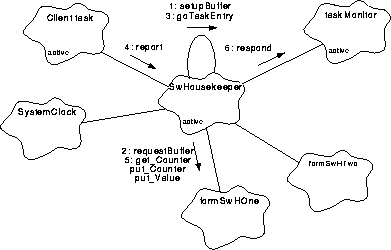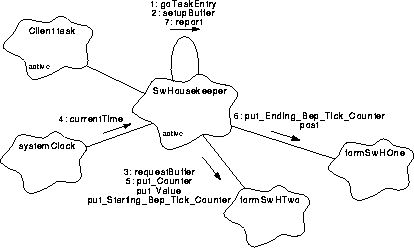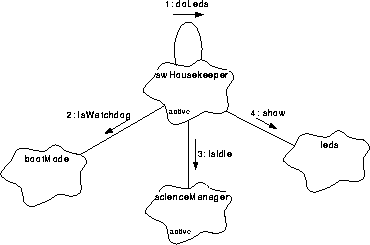 Table of Contents
Table of Contents
 Previous Chapter
Previous Chapter
ACIS
The Software Housekeeper provides the statistical repository for the various active tasks. Periodically it delivers the database to be telemetered, and begins a fresh accumulation of software data. This process is initiated during start-up and persists until CPU reset.
The frequency with which the housekeeper attempts to deliver packets is one per minute (patchable).
- A method of acquiring reported statistical values
- A system for periodically delivering the accumulated statistics.
- Periodically indicate instrument state using software discrete telemetry (LEDs)
Figure 136 illustrates the relationship between the classes used by the Software Housekeeper.
FIGURE 136. Software Housekeeper Class Relationships

The Software Housekeeper uses the Executive, Protocols, Science and Devices class categories.
SwHousekeeper - This class is a subclass of Executive::Task. It is responsible for accumulating and delivering software housekeeping statistics reported by other processes. It provides functions which clients use to report statistics (report), and includes a main task function (goTaskEntry).
Tf_Sw_Housekeeping - This class encapsulates the representation of a telemetry packet. It is a subclass of Protocols::TlmForm and is generated by the IP&CL code generator. The SwHousekeeper contains two instances of this class, which are used to format and post software housekeeping telemetry packet buffers. It provides functions which write the starting and ending integration times (put_Starting_Bep_Tick_Counter, put_Ending_Bep_Tick_Counter), read and write the current statistic counter (get_Counter, put_Counter), and set the value field associated with the statistic (put_Value).
SystemClock - This class provides the Back End Processor tick count (currentTime) which is included with the Software Housekeeping Database. It is provided by the Executive class category.
Leds - This class is provided by the Devices class category and is responsible for setting the current software discrete telemetry value (show). The SwHousekeeper class uses this class to indicate the current state of the instrument software.
BootMode - This class is provided by the Devices class category and is responsible for providing the cause of the most recent reset of the Back End Processor. The SwHousekeeper uses this class to determine if the Watchdog timer caused the most recent reset of the Back End (isWatchdog). This information is used to indicate the current state of the instrument in the software discrete telemetry.
ScienceManager - This class is provided by the Science class category and is responsible for managing science runs. The SwHousekeeper uses this class to determine whether or not a science run is active (isIdle) This information is used to indicate the current state of the instrument in the software discrete telemetry.
TlmAllocator - This class is provided by the Protocols class category and is responsible for managing pools of telemetry packet buffers. All software housekeeping telemetry packets are allocated from a single pool, managed by the swHouseAllocator instance of this class.
TaskMonitor - This class (not shown) is a subclass of Executive::Task. It is responsible for insuring that active tasks are responsive, (not subverted by an SEU, etc.).
The Software Housekeeper task has a quiescent period during which statistics are accumulated. When activated, it initiates an attempt to obtain a fresh database; failing, it continues
accumulating into the current telemetry packet data array; succeeding, a fresh new array becomes available and the former packet is delivered to be telemetered. Since statistics are accumulated directly into telemetry buffers, they are subject to single-event upsets (SEUs). The expected SEU rate into the 1Mbyte telemetry buffer memory is from 1 to 100 hits per day, and the maximum size of a single telemetry buffer is 4092 bytes. A housekeeping data point may be corrupted about once every two or three days.
On each attempt, the housekeeper sets the software discrete telemetry bits (LEDs) to indicate the current state of the instrument (see Section 4.3.2 ).
These states include:
Science is idle
Science is running
Instrument was reset by the watchdog timer and Science is idle
Instrument was reset by the watchdog timer and Science is running
Each of these states use two different discrete telemetry codes. The housekeeper switches between each code on each iteration to indicate to the ground that the housekeeper is active (see the ACIS Software IP&CL, MIT 36-5302.0204, for the formal list of code assignments).
The software discrete bi-levels are periodically sampled by the spacecraft via the RCTU, and are included in the engineering portion of telemetry. The sample rate is TBD, but is expected to be once per Major Frame (i.e. about twice a minute). The final location of the bi-level signals within the telemetry frame, and their sample rate will be specified in the final version of the AXAF-I Instrument Program and Command List (IP&CL), provided by TRW (part # TBD).
Each of the housekeeping statistics are comprised of two items; the number of times each entry was reported during the period, and an associated value. An enumerated list is used to specify the data items reported. The accumulating process will increment the count of occurrences in the first item of the two item data structure installed at the enumerated database location as each incident is deposited. The associated values' meaning and representation is entirely application dependent. It is stored as an unsigned integer.
Any process may be a client of the software housekeeper. It is the clients responsibility to
deliver whichever statistical data are desired. The housekeeper does not solicit items to be included in the statistics.
Figure 137 illustrates the operation of the Software Housekeeper data accumulation process.
FIGURE 137. Software Housekeeper Accumulation

- During the system initialization, the constructor, SwHousekeeper(), passes a pointer to formSwHOne to SwHousekeeper::setupBuffer() to initialize the first packet buffer. Once the buffer is setup, it sets the form pointer, currentPtr, to point to formSwHOne. Once running, the housekeeper switches this pointer between formSwHOne and formSwHTwo to allow statistic accumulation while the other's telemetry packet buffer is being sent.
- setupBuffer() uses formSwHOne.requestBuffer() to obtain the initial telemetry packet buffer, and initializes the contents of the buffer (see Section 28.4.3 ).
- Once the system starts multi-tasking, the housekeeper's task function, goTaskEntry() is invoked. This function contains an infinite loop during which it waits in intervalWait() (not shown) while statistical data accumulates, then delivery of the housekeeping database packet is initiated.
- The client task, any active software process, may deposit information whenever necessary, or desirable using SwHousekeeper::report().
- The software housekeeper report() function disables interrupts by declaring an instance of IntrGuard (not shown). It then reads the current statistic value using currentPtr->get_Counter(), increments the returned value and writes it back into the value using currentPtr->put_Counter(). It then writes the report value using currentPtr->put_Value(). Upon returning, the IntrGuard instance is destroyed, and the previous interrupt state is restored.
- Meanwhile, the TaskMonitor, on its own schedule, will query the software housekeeper to determine if it is viable. During its accumulation period the housekeeper would reply using TaskMonitor::respond().
Figure 138 illustrates the operation of the Software Housekeeper packet delivery process.
FIGURE 138. Software Housekeeper Delivery of Statistics

- The software housekeeper thread, goTaskEntry(), associates the local pointer, nextPtr with the packet instance-in-waiting. During operation, the software housekeeper will alternate between this packet instance and the instance currentPtr associated in the constructor. The software housekeeper then enters its main task loop during which data accumulates and delivery of the housekeeping database packet is initiated.
- At the end of the accumulation period, the housekeeper passes nextPtr to setupBuffer() to attempt to stage the next accumulation telemetry buffer.
- setupBuffer() calls form->requestBuffer() to attempt to obtain a second telemetry packet buffer.
- If the request succeeds, setupBuffer() calls systemClock.currentTime() to obtain the current BEP tick counter value (NOTE: This 1/10th second operating system timer is not the same as the science timestamp counter).
- setupBuffer() then zeros the buffer's counter and value entries using form>put_Counter() and form->put_Value(). It then stores the starting integration time using form->put_Starting_Bep_Tick_Counter(). setupBuffer() supplies its caller with the counter value to delimit the end of the previous buffer's integration.
- Once the second buffer has been obtained and initialized, goTaskEntry() swaps telemetry packet buffers by switching the values of currentPtr and nextPtr, through the temporary pointer, priorPtr. It then stores the ending integration BEP tick counter into the old buffer using priorPtr>put_Ending_Bep_Tick_Counter(). It then posts the old buffer to telemetry using priorPtr->post().
- Should another buffer not be available, software statistics will continue to accumulate in the current packet buffer. The housekeeper will record the incident in the database using its own report() function.
Figure 139 illustrates the method used by the Software Housekeeper to periodically update the software discrete telemetry levels.
FIGURE 139. Update Instrument State Indicators

- Once per iteration of its infinite loop, the Software Housekeeper's main task function, goTaskEntry(), calls doLeds() to update the software discrete telemetry state.
- doLeds() determine if the most recent reset was due to the watchdog timer using bootMode.isWatchdog().
- doLeds() determine if a science run is underway using scienceManager.isIdle().
- doLeds() uses the acquired boot and science state information, and the current state of the aPhase instance variable to select the appropriate LED code, and writes the code to the software discrete telemetry bits using leds.show().
Documentation
- The SwHousekeeper periodically initiates telemetering of accumulated statistical data provided by various software elements. During the normal course of their operation, the software tasks, which are intended to provide statistics, will call the software housekeeper and deliver the pertinent data which will be installed into the software housekeeping data structure. Periodically, the housekeeper will attempt to obtain a packet buffer for the replacement database. Failing, it will report the incident, and continue to accumulate in the current database. Succeeding, it will swap databases, initiate delivery of the acquired data to the telemetry service, and begin a new accumulation period.
Export Control: Public
Cardinality: 1
Hierarchy
- Superclasses: Task
Public Interface
- Operations:
SwHousekeeper()
goTaskEntry()
report()
Private Interface
- Operations
doLeds()
intervalWait ()
setupBuffer()
- Has-A Relationships:
- Tf_Sw_Housekeeping formSwHOne: This is an instance of a software housekeeping packet form. A packet buffer in bulk memory will be associated with this instance.
- Tf_Sw_Housekeeping formSwHTwo: This is an instance of a software housekeeping packet form. A packet buffer in bulk memory will be associated with this instance.
- Tf_Sw_Housekeeping *currentPtr: This pointer is used to indicate which software housekeeping packet is currently available to be filled with data
- Boolean aPhase: This indicates the current software discrete telemetry (LED) ping-pong state. This code toggles between BoolTrue and BoolFalse as the LEDs are periodically updated.
- const unsigned accumInterval: This variable contains time, in BEP timer ticks (10 per second)), over which to accumulate software housekeeping statistics. If telemetry resources are available, one housekeeping packet will be sent after each interval. The interval duration is approximately 1 minute.
- const unsigned statCount: This is the largest statistic code used by the housekeeper (NOTE: The class constructor initializes this value to SWH_MAX_STAT = 64. To modify this value, patch the constructor.).
Concurrency: Active
Persistence: Persistent
Public member of: SwHousekeeper
Arguments
unsigned taskId:: Identifies the task being constructed.
Documentation
- The SwHousekeeper() constructor initiates acquisition of the first software housekeeping statistics database packet.
Preconditions
- It is expected that functions which provide a telemetry packet will be in place when this function is constructed.
Semantics
SwHousekeeper() uses setupBuffer(), which acquires the packet buffer. The Buffer MUST have been obtained, or a fatal error will be generated!
Concurrency: Guarded
Private member of: SwHousekeeper
Return Class: void
Documentation
- This function blinks the software discrete telemetry bits (LEDs) to indicate the current state of the instrument. The state of the LEDs are changed on each call to this function.
Semantics
- This list of housekeeping LED codes is as follows, where their values are defined in the ACIS Software IP&CL, MIT 36-53204.0204:
LED_WD_SCIENCE_A
LED_WD_SCIENCE_B
LED_WD_IDLE_A
LED_WD_IDLE_B
LED_RUN_SCIENCE_A
LED_RUN_SCIENCE_B
LED_RUN_IDLE_A
LED_RUN_IDLE_B
- Use bootMode.isWatchdog() to determine if watchdog cause the most recent reset. If so, select the LED_WD_* set of LED codes, otherwise, select the LED_RUN_*.
- Use scienceManager.isIdle() to determine if science is performing a run. If so, select the LED_*_SCIENCE_* set of codes, otherwise, select the LED_*_IDLE_* set.
- Toggle between LED_*_*_A and LED_*_*_B on each call to the function. Use the aPhase instance variable to determine which blink state to use. If aPhase is BoolFalse, select the LED_*_*_B set of LEDs, and set aPhase to BoolTrue. If aPhase is already BoolTrue, use the LED_*_*_A set of codes, and set aPhase to BoolFalse.
- Use the selection code to lookup the corresponding LED code, and write the code using Leds::show().
- .
Concurrency: Guarded
Public member of: SwHousekeeper
Return Class: void
Documentation
- goTaskEntry() is the initiation point for the software housekeeper. On a regular basis, it initiates dispatch of the accumulated housekeeping statistics being telemetered.
Preconditions
- The constructor for SwHousekeeper() has initiated the first packet.
Semantics
- On start-up, goTaskEntry() associates a pointer with the second Tf_Sw_Housekeeping software housekeeping packet. It then enters a FOREVER loop, and remains inactive in intervalWait() for a fixed time period (accumInterval) during which statistics are accumulated into the telemetry buffer. When activated, it initiates an attempt to obtain a replacement empty telemetry packet buffer using setupBuffer(). If it is successful, it will switch packet buffer pointers and begin accumulating into the fresh packet buffer database, store the ending integration time into the prior buffer, and post it to telemetry using TlmForm::post(). Otherwise, it will record the condition using SwHousekeeper::report() to record a skipped software housekeeping packet delivery (statistic), before continuing accumulation in the same packet during the ensuing interval. At the end of each iteration, goTaskEntry() calls doLeds() to update the software discrete telemetry codes.
Post Conditions
- This procedure never returns.
Concurrency: Guarded
Private member of: SwHousekeeper
Return Class: void
Documentation
- intervalWait() idles the process for a predefined period. During this interval, housekeeping reports are filed by various entities. Also, during this accumulation period, intervalWait() will respond to taskMonitor() interrogations.
Semantics
- intervalWait() idles in waitForEvent() while it waits for the monitor (are you alive) interrogation events or for accumInterval number of Science Frame pulse timing tick events. It will respond to the interrogation and will count the requisite number of pulses before returning.
Concurrency: Guarded
Public member of: SwHousekeeper
Return Class: void
Arguments
- SwStatistic statisticId:: Identifies the statistic being recorded.
- unsigned value:: Contains a (possibly irrelevant) associated value.
Documentation
- report() is the vehicle provided to accumulate the referenced statistics which the software housekeeper will deliver.
Semantics
- First, the function tests currentPtr and returns if it is NULL. If currentPtr is not NULL, it verifies that the statisticId is within range (i.e. be less than statCount). If not, it sets the statistic id to SWSTAT_SWHOUSE_RANGE. It then disables by declaring an IntrGuard instance. It then uses currentPtr->get_Counter() and currentPtr->put_Counter() to read, increment and write the counter indexed by statisticId. It then uses currentPtr->put_Value() to store value. Upon returning, the IntrGuard destructor restores the original interrupt enable state.
Concurrency: Synchronous
Private member of: SwHousekeeper
Return Class: Boolean
Arguments
- Tf_Sw_Housekeeping* form:: Points to telemetry formatter
- unsigned& starttick:: Used to return integration start time
Documentation
- This function sets up a telemetry packet buffer for the telemetry form, pointed to by form. If a buffer is successfully obtained, the function sets starttick to the starting integration BEP timer-tick value and returns BoolTrue. If a telemetry packet buffer is not available at the time of the call, the function returns BoolFalse.
Semantics
- Call form->requestBuffer(). If successful, call systemClock.currentTime() to obtain the current timestamp, zero the statistics counters and values using form->put_Counter() and form>putValue(). Store the starting timer tick using form>put_Starting_Bep_Tick_Counter() and return BoolTrue. If form->requestBuffer() fails to obtain a packet buffer, return BoolFalse.
Concurrency: Guarded
 Table of Contents
Table of Contents
 Next Chapter
Next Chapter
 Table of Contents
Table of Contents
 Previous Chapter
Previous Chapter
 Table of Contents
Table of Contents
 Previous Chapter
Previous Chapter